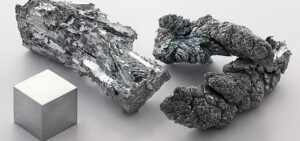
In January 2025, Ukraine reduced imports of zinc and zinc products by 34.2% compared to the same period in 2024 to $2,695 million. In December 2024, imports amounted to $3,802 million. Zinc exports in January amounted to $137 thousand (in December – $100 thousand), while in January 2024 it was at the level of $8 thousand.
Pure zinc metal is used to reduce precious metals, protect steel from corrosion and for other purposes.

In January 2025, imports of tin and tin products decreased by 11.5% compared to January 2024, to $230 thousand. In December 2024, this figure was $338 thousand.
Tin is used mainly as a safe, non-toxic, corrosion-resistant coating in its pure form or in alloys with other metals. The main industrial applications of tin are in white tinplate (tinned iron) for food containers, in solders for electronics, in house pipelines, in bearing alloys, and in coatings made of tin and its alloys. The most important tin alloy is bronze (with copper).

In January of this year, Ukraine increased imports of coke and semi-coke in physical terms by 2.2 times compared to the same period last year – up to 92.501 thousand tons from 42.885 thousand tons.
According to the statistics released by the State Customs Service, coke imports in monetary terms increased by 79.8% to $29.881 million over the period.
Imports were mainly from Poland (66.51% of supplies in monetary terms), Indonesia (32.01%) and the Czech Republic (1.46%).
The country did not export coke last month.
As reported, in 2024, Ukraine increased imports of coke and semi-coke in physical terms by 2.01 times compared to 2023 – up to 661.487 thousand tons, in monetary terms, imports increased by 81.9% to $235.475 million. Imports were carried out mainly from Poland (84.76% of supplies in monetary terms), Colombia (7.74%) and Hungary (2.69%).
In 2024, the country exported 1,601 thousand tons of 84.76% coke for $368 thousand to Moldova (99.18%) and Latvia (0.82%), while in January, March, October and November 2024, there were no exports, while in 2023, exports amounted to 3,383 thousand tons for $787 thousand.

In January 2025, Ukraine increased imports of lead and lead products by 4.3 times compared to the same period in 2024, to $580 thousand (in December – $1.193 million). At the same time, lead exports decreased by 26.3% to $643 thousand (December: $583 thousand).
Lead is currently mainly used in the production of lead-acid batteries for the automotive industry. In addition, lead is used to make bullets and some alloys.

In January 2025, imports of aluminum and aluminum products increased by 9.4% year-on-year to $36.658 million (in December – $36.943 million). In January, aluminum exports increased by 17.9% to $9.431 million, while in December this figure was $8.426 million.
Aluminum is widely used as a structural material. The main advantages of aluminum are its lightness, stampability, corrosion resistance, high thermal conductivity, and non-toxicity of its compounds. In particular, these properties have made aluminum extremely popular in the production of cookware, aluminum foil in the food industry, and packaging. The first three properties have made aluminum the main raw material in the aviation and aerospace industries (recently it has been replaced by composite materials, primarily carbon fiber). After the construction and production of packaging, such as aluminum cans and foil, the energy sector is the largest consumer of the metal.

Imports to Ukraine of power generating sets and rotating electrical converters (UKTZED 8502) in January-2025 increased almost eightfold in monetary terms compared to January-2024, to $178.36 million, according to statistics from the State Customs Service (SCS).
According to the State Customs Service, in January of this year, the most frequently imported electric generators and converters were from Austria (14.1% of total exports of these products or $25.13 million), the United States (13.6% or $24.2 million) and Romania (13.3% or $23.7 million), while a year earlier it was the Czech Republic ($6.7 million), China ($5.6 million) and Turkey ($3.4 million).
In addition, in January, imports of electric batteries and separators to Ukraine more than tripled to $94.83 million, most often imported from China (77.8%), Bulgaria (11%) and Taiwan (3.3%).
As reported, at the end of July 2024, Ukraine exempted the import of power generating equipment and batteries to Ukraine from customs duties and VAT.
According to the State Customs Service, in 2024, imports of electric generators and converters to Ukraine increased by 3.7% compared to 2023, to $732.5 million, and batteries more than doubled to $950.6 million.